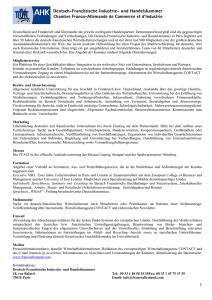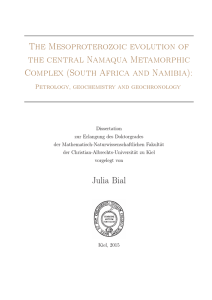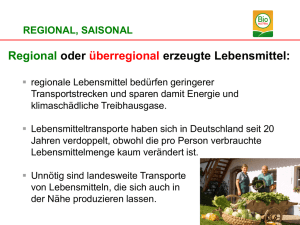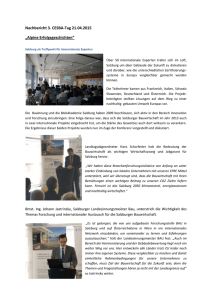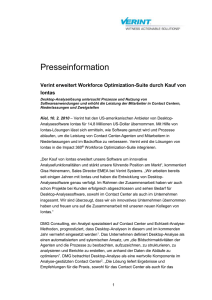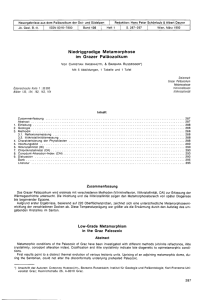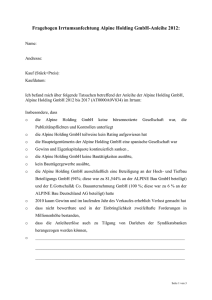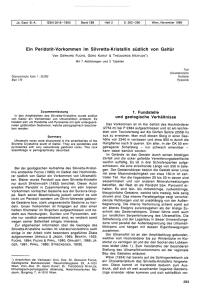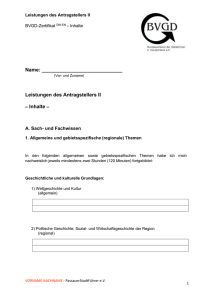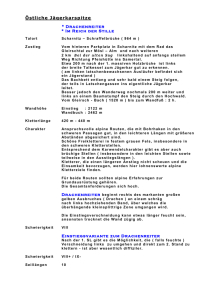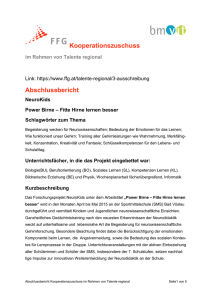Abstract - ETH E-Collection
Werbung
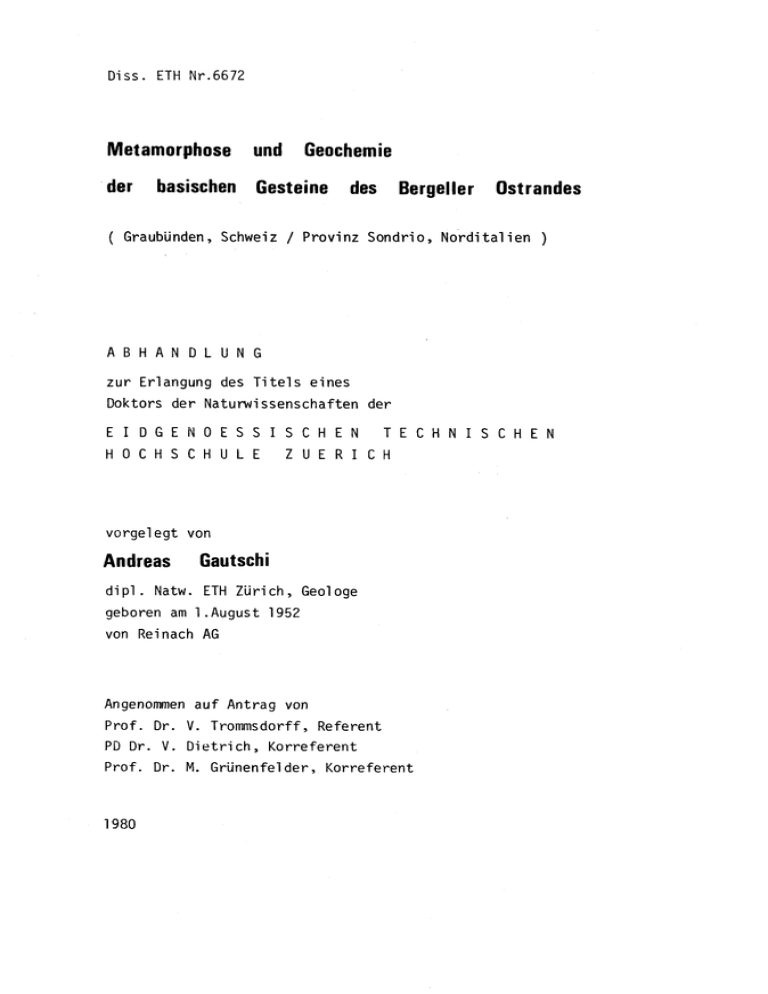
Diss. ETH Nr.6672 Metamorphose basischen der ( Graubünden, Geochemie und Gesteine des Bergeller Ostrandes Schweiz / Provinz Sondrio, Norditalien ) ABHANDLUNG zur Erlangung Doktors des Titels eines der Naturwissenschaften der EIDGENOESSISCHEN HOCHSCHULE vorgelegt Gautschi dipl. Natw. von am ETH Zürich, Geologe I.August 1952 Reinach AG Angenommen Prof. PD Dr. Prof. 1980 ZUERICH von Andreas geboren TECHNISCHEN Dr. V. Dr. auf V. Antrag von Trommsdorff, Referent Dietrich, Korreferent M. Grünenfelder, Korreferent ZUSAMMENFASSUNG Bergeller Intrusion (östliche Zentralalpen; Oestlich der tertiären Kt.Graubünden, Schweiz/Prov.Sondrio, Norditalien) treten in verschiede¬ Positionen des nen I- alpinen Deckengebäudes basische Gesteine auf (Fig.1). 91§_§5§ilS§_der_Margnadecke Der Fedozer ist ein Gabbro gebildeter Metagabbrokomplex innerhalb der alpinen Regionalmetamorphose fast Margna-Altkristall Bergeller Kontaktmetamorphose erkennen. Die ins. Gesteine haben ein charakteristische Mineralien Koronabildungen Ueberprägung durch granoblastisches Gefüge Gleichgewichtstemperaturberechnungen Olivin Gabbronorit für das und Olivin (z.T.). Komplexe Plagioklas auf, die Reaktio¬ wo 800°C. tive lassen auf Drucke Die von sind. in einem was für eine Die Temperaturen der aus von von 800°C experimentellen P>6kb für die für die Daten liegen and und für 825 C respek¬ um Olivin-Plagioklas (GREEN Reaktion RINGWOOD,1967 u.a.) Koronabildung schliessen. progressive Umwandlung der granulitischen Metagabbros durch die alpine Regionalmetamorphose ist eine reine Funktion der angebotenen und somit stark menge frischen vom mag¬ für die Subsolidus-Re- Reaktion Olivin-Plagioklas Ent¬ ursprünglich Klinopyroxen (Opx-Entmischungslamellen im Cpx) Die Temperatur aufgrund (1977) ergaben nach WELLS 1000°C, um matische Kristallisation spricht. Opx/Cpx-Paar und ent¬ Opx/Cpx als Gesamtphasen (d.h. inkl. Paar mischungslamellen) Temperaturen das die Plagioklas (An 50), Klinopyroxen, zwischen Olivin und treten im Die gut erhal¬ 01+Plag=Al-0px+Al-Cpx±Sp und 01+Plag=0px+Gr+Amph abgelaufen equilibrierung von flaserige Chlorit- konnten erstmals Es Orthopyroxen, Ilmenit, grünen Spinell (z.T) nen Er voralpinen Granulitfazies-Metamorphose gefunden werden. granulitischen halten als aus¬ -gneise umgewandelt worden. westlichsten Teile lassen noch eine zusätzliche Relikte einer in vollständig Aktinolith-Klinozoisit-Albitschiefer und tene stratiform typischen tholeiitischen Differentiationstrend und ist einen zeigt des lokal Wasser¬ deformationsabhängig. Sämtliche Uebergangsstadien, granulitischen Metagabbro, bis zu den flaserigen Chl-Akt-Klz- Albitschiefern, können beobachtet werden. Die hohe aktinolithischen Amphibole Glaukophangehalte (Na rakter der , AI der ), flaserigen Metagabbros wodurch sich ein haben relativ druckbetonter Cha¬ alpinen Grünschieferfazies-Regionalmetamophose manifestiert. Im Einflussbereich der morphen Aktinolithe Bergeller einer von Intrusiva werden die pargasitischen Hornblende regionalmetaumwachsen. neugebildeten Amphibolrändern zeigt die zunehmende diesen Na+K eine starke zung durch A-Platz Beset¬ Temperaturzunahme gegen den Tonalitkontakt Der kontaktmetamorphe ten (=konstant niedrige Drucke) Charakter ist aus den konstant niedrigen dass der Fedozer Gabbro nicht spielsweise auf der 1972) gezeigt an. -Gehal¬ Geologischen lassen erken¬ ophiolithisehen Ursprungs ist, wie bei¬ Karte der Schweiz 1:500'000 (Ausgabe ist. Amphibol ite (s.str) erscheinen als tungen im Chiareggiogneis der Margnadecke. auf ein Na M4 ersichtlich. Metamorphosegeschichte und geologische Feldbeobachtungen nen, In tholeiitisches Immobile Stammagma hin, Aussagen Stellung (kontinental, ozeanisch etc.) geringmächtige weisen Spurenelemente über die sind nicht Einschal¬ geotektonische möglich. Eine voralpine Metamorphose konnte wegen der starken alpinen Ueberprägung im ChiareggioGebiet noch nicht 1* !?!§_§§§i!S§_^§r_9£!]i2l!thzone_Mal enco^Li zun • Die i t (Amphibolitkörper Cassandra-Amphibolite Malenco-Ultramafitits) innerhalb des 1 nachgewiesen werden. (Metabasalte, e z.T. mit und die bo- Forno-Amphi sind Pillowstrukturen) geochemisch mit spilitisierten ozeanischen Tholeiitbasalten vergleichbar. Die Cassandra- Amphibolite entsprechen primitiveren Tholeiiten als die Forno-Amphibolite. Sie können deshalb nicht als ein laterales extrusives Aequivalent der For- nobasalte betrachtet werden. Die Cassandra- und Forno-Amphibolite ler Kontaktaureole auf. (Na vorwiegend ten. Gegen den auf phibol Albit sprunghafte (neben Plagioklas) Abnahme des der ausgeprägte retrograde schränkt und weist ebenfalls Bergel¬ Epidot, in Ca- wird zunehmend anorthit- verschwindet in den Am¬ (der eingeschuppten Ultramafitite) Zone phen Amphibolen, währenddem schwach Chlorit und Diopsid gebildet. Plagioklas iten der Talk-Olivin innerhalb der regional metamorphe Amphibolkerne Intrusivkontakt verschwinden (bis Bytownit). bewirkt eine nur sind im äusseren Bereich der Aureole erhal¬ M4-Platz) reicheren Lagen wird reicher Reliktische treten Edenitgehaltes Ti-Gehalt Phase in den kontaktmetamor- kontinuierlich zunimmt. ist auf das Val und Eine Sissone-Gebiet be¬ charakteristische Züge einer Kontaktmetamor¬ phose auf. Sie kann auf eine lokale zweiphasige Kontaktmetamorphose (Tonalit-Granodiorit) oder auf eine Aplitgranite) zurückgeführt 1er Sissone-Gebiet keine spätere magmatische Phase (Bergel- werden. Für die von BUCHER (1977b) im postulierte postbergellische Regionalmetamorphose wurden Anhaltspunkte gefunden. Basische_Gänge III. andesi Undeformierte, postregional metamorphe basaltische Margnadecke und Gänge Gänge Bergeller der Kontaktmetamorphose noch erfasst worden. von Ausserhalb der Kontaktaureole zeigen sie noch den ursprünglichen magma¬ (basischer Plagioklas, hastingsitischer Amphibol) tischen Mineralbestand sowie In der Nähe der im Malenco-Ultramafitit auf. Intrusiva sind die verschiedenen Serien der in treten tisch¬ typische felsitische Abkühlungsränder mit Flui daltexturen. Alters- mässig (postregionalmetamorph-präbergellisch) ist ein Zusammenhang mit dem oligocänen Gang-Magmatismus In den basischen gleiche Abfolge Gesteinen des und den West- Bergeller alpinen der erkennbar: nisse in Ostalpen möglich. Ostrandes ist überall Metamorphoseereig¬ Ueberprägung einer syn- bis postkinematischen Regionalmetamorphose durch die jüngere Kontaktmetamorphose bereich der kann für die Bergeller Intrusiva. Aufgrund Regionalmetamorphose angenommen werden. die der im Einfluss¬ publizierten Altersdaten ein oberkretazisches Alter (eoalpin) Der druckbetonte Charakter der Grünschieferfazies- Metamorphose steht damit in Einklang und zeigt gleichzeitig, dass wäh¬ rend der eoalpinen Phase die nicht erreicht worden sind. Bedingungen Eine einer Ueberlagerung metamorphose durch die "lepontinische" (meso- sephase ist am Bergeller weiter im Westen statt. Hochdruckmetamorphose der bis eoalpinen Regional¬ neoalpine) Metamorpho¬ Ostrand nicht nachweisbar, sondern findet erst ABSTRACT East of the the alpine 1 Central Alps, Swiss/ pile. The polymetamorphic history and the geochemistry nappe rocks of these (Eastern basic rocks outcrop in different tectonic positions of border) Italian intrusion Tertiary Bergell considered in this paper. are I!]§_^§i9_r29!S§_2f_tt]§_Margna_na2ge • In the F e d o Gabbro, z Malenco ultramafic body, well facies a preserved relics of a pre-Alpine granulite metamorphism have been discovered for the first time. The main part of the has mass gneisses pine regional metamorphism. Bergell tonalites overprinting the "flaser been transformed into nolite-clinozoisite-albite and In subsequent event, a granodiorites resulted western trend is in the intrusion of the metamorphism contact a part of the meta-gabbros. In the gabbro com¬ tholeiitic differentia- a recognized. granulitic rocks have The type" chlorite-acti- by the superimposed Al¬ and schists plex which locally shows stratiform features, tion north of the metagabbro complex texture and consist of granoblastic a pla¬ gioclase (An 50), clinopyroxene, orthopyroxene, ilmenite,occassional spinel and olivine. Corona forming reactions using the method of WELLS the opx/cpx and for the kb on for pair in cpx reequilibration 800°C respectively. the basis for this progressive of The as cristallisation. (opx-lamellae reaction calculagave phases" (incl. "host in Temperatures cpx) plagioclase equilibration temperatures of and for are around 800°C reaction leads to estimated pressures of P experimental datas of GREEN and RINGWOOD (1967) (1). transformation of the of water and to the effects granulitic metagabbros by to of deformation. mation, from granulitic meta-gabbros be observed. olivine-gabbronorite from reaction between olivine and Alpine regional metamorphism is believed can an opx/cpx pair for the olivine-plagioclase and others The 1000°C (1977) lamellae) suggesting magmatic for the subsolidus 6 Al-opx+Al-cpx ol+plag=opx+gar+amph (2). Equilibrium temperature exsolution > = and temperatures around 825°C ol+plag (1) ±spinel tions are green to be All due to the the availability stages in this transfor¬ flaser type chl-act-clz-ab schists The actionlitic amphiboles tively high glaucophane higher (Na contents flaser type meta-gabbros have relaM4 AI , VI ) reflecting a somewhat Alpine greenschist facies regional the during pressure of the metamor¬ phism than observed in greenschist terrains. In rocks later affected by the morphic actinolites sing occupation reflects a are Bergell intrusion, overgrown by of the A-site by the regional pargasitic hornblende. Na+K in these pargasitic hornblendes tactmetamorphic character is also evident by constantly low The low are logical Map ophiolitic origin, of not of Switzerland 1:500*000 Amphiboltes Chiareggio gneiss be immobile to of the (s.str.) Margna types, however in example to the as intercalations thin Trace elements which in Geo- the believed are show affinities with tholeiitic magma geotectonic setting (e.g. Conti¬ nental, oceanic) is not possible using this data. Evidence for pine metamorphism could -contents indicate that the Fedoz for contrast occur discrimination of the a Na con- (1972 edition). nappe. during metamorphism The M4 amphiboles. and field observations metamorphic history Gabbros in these pressure) increa- The temperature increase towards the tonalite contact. (= constantly meta- pre-Al- a yet be found, because of the strong Alpine not overprint in the Chiareggio region. 11 !!3§_^§i9_r22^§_2f_5!]§_22bi2ll^_?2D§_!!l?§l§D,r2:!:l?y0 • The geochemistry of the Cassandra within the Malenco (amphibolite body amphibolites are with comparable amphibolites correspond ultramafics) (meta basalts, locally spilitized to ocean more amphibolites. Therefore they amphibolites and the with cannot be tholeiites considered as o r o n pillow structures) floor tholeiites. primitive F The Cassandra than the Forno a lateral equiva- lent of the Forno basalts. The Cassandra and Forno contact aureole. in M4 site) are Relict to appears. bytownite) disappears in chlorite and Plagioclase towards the within the regional metamorphic amphibole preserved in the tonalite intrusion diopside amphibolites outcrop only outer cores part of the aureole. Bergell (Na mainly Towards the epidote disappear and in Ca-rich layers becomes the contact. increasingly anorthite Albite rieh (up (coexisting with plagioclase) amphibolites of the talc-olivine zone (of the inter- slices), causing calated ultramafic Sharp drop in the edenite a of the contact metamorphic amphiboles, whereas the continuously. A to the Val content increases Ti metamorphism, suchas this characteristic features of and shows region was due either to probably metamorphism (tonalite-granodiorite) gell aplite granites). restricted is weakly developed retrograde metamorphism Sissone or No evidence has to been later a content twophase a contact a contact magmatic phase (Ber¬ post-Bergell found for the regional metamorphism postulated by BUCHER (1977b). Basic_dy_kes III. Undeformed, post-regional metamorphic andesitic-basaltic dykes in the Malenco ultramafic sion these dykes contact aureole with body. these fluidal Alpine of syn- to An upper metamorphism sures of the siStent with a "real" on Cretaceous the basis Beyond the chilled as these data. an overprint to found further west. mar- Alps. Bergell massif the events is sequence*of same always recognized: postkinematic regional metamorphism by in neighbourhood the (Eoalpine) of published radiometric for this data. Thus during of the the were a regional Elevated presare con- Eoalpine phase conditions not reached. East cannot be of of the Ber¬ Eoalpine regionalmetamorphism by Neoalpine) metamorphism sub- Bergell intru- of the proposed age is oligo- with the Alpine greenschist facies regional metamorphism "Lepontine" (Mesois and Eastern high-pressure metamorphism gell massif, well possible correlation a in the Western sequent contact metamorphism sion. allow rocks east of the a intru- assemblages (anor- mineral as Bergell Age relations (regional metamorphism-dyke in- metamorphic overprint of the neighbourhood dykes retain primary textures. dyke-magmatism In the basic the the nappe and Margna affected by the contact metamorphism. are trusion-contactmetamorphism) cene In plagioclase, hastingsitic amphibole) thite-rich gins of the in different series Alpine schistosity cut the cross- the detected but
